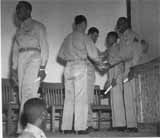THE TUSKEGEE AIRMEN MOVIE

Pilots receiving their commission into the army
From: Double V: The Civil Rights Struggle of the Tuskegee Airmen
The movie staring Lawrence Fishburne and Cuba Gooding Jr. began with the potential black cadets riding a train to Tuskegee. In the middle of the night, they were awoken and shoved out of their seats and off the train. The people that were replacing them in their seats were white prisoners. The black men had to move to another train. This scene would set the precedent on how they would be treated through their aviation careers.
The men arrived at Tuskegee and began their training as the 99th Squadron. They had to take the Air Corp written exam even though they already passed it. Major Joy would be training them in aviation and was a racist and thought it was a waste of his time to train these men. But all of the men passed the exam with no one getting lower than a 95. One cadet died when flying a plane with his trainer and another was dismissed from the Corp for joy riding. He eventually would take one of the planes and fly to his death. After training, the airmen were finally sent to Morocco, North Africa. There they met their commander, Benjamin O'Davis, who was the first Negro man to graduate from West Point, who was given the silent treatment all four years.
Their mission in North Africa was to bomb German supplies and another mission was to bomb the German airfield and power station. Both of these were successful. But the men were doing nothing but ground runs, while the white fighters already moved out of the camp to fight in France. At the same time, a Senator from back home was trying to stop the experiment program of the Tuskegee airmen. He found bogus statistics about them and made false accusations of their flying ability. But he couldn't convince the committee to cancel the program after the speech by Lt.-Col. Davis who was accompanied by a white General and supported by one of the Senators. The men were then sent to Italy to be joined by the 100th, 301st and 302nd. These and the 99th would then be called the 332nd fighter group. Their mission changed from dive-bombing to bomber escort.
The camp they were at was once again segregated. The pilots would by flying mustangs, which they painted the tails red. Lt. Lee and Lt. Capi saved a bomber whose escorts consistently did not meet them at the rendezvous point. But when the men found out they were colored pilots, they became indifferent. The Tuskegee men also destroyed an enemy destroyer in which the pilot received a medal. The 332nd escorts were always on time and hadn't lost a bomber yet in the war. They were personally requested by the 51st bomber squadron to be their escorts for their mission to Berlin. The escorts shot down three German planes; the first in the war and the raid of Berlin was successful. 66 died in the war and they never lost a bomber under their escorts.
This movie is very significant in explaining what the African American community went through not only at home but also abroad. This movie shows the reality of what the men had to endure in order to become pilots for the Army Air Corp and how successful they were. Many of these pilots would become high ranks within the army after the war, still with much discrimination. One movie review states, "this film does a magnificent job telling the tale without being melodramatic, preachy or snide, but does full justice to the accomplishments of the pilots and their eventual victory against both German pilots and their own nation's refusal to recognize their talents" (Amazon website review). An article entitled "The Legacy of the Tuskegee Airmen" states that between July 1944 and March 1945, "the 332nd destroyed and damaged more than 136 enemy aircraft in aerial combat" (Carter, 13). This is an amazing feet and is overlooked within the military world. But this movie captures the essence of the Tuskegee men, their struggles and accomplishments.
Museum of the Tuskegee Airmen
Home page
